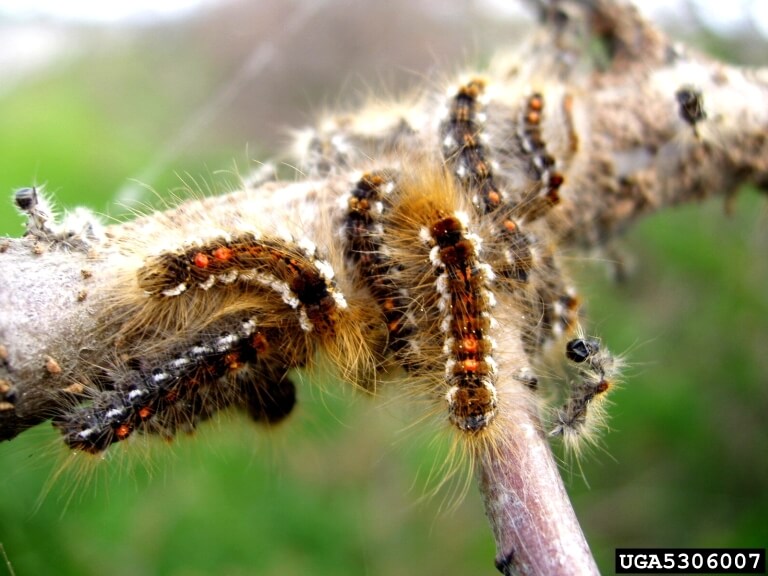
The browntail moth is native to Europe and neighboring countries in Asia and North Africa. It was first detected in Massachusetts in 1897 (Boyd 2019). It quickly spread through New England and Canada. Significant efforts were made to find biological control agents; 16 parasitoids and predators were released and nine established (Boyd 2019). Browntail moth populations declined to low levels for nearly a century. In 2016 a large outbreak began in southern Maine (Boyd 2019). This outbreak continues. In 2018, defoliation attributed to the browntail moth was detected on 55,000 ha in New England, focused on the Central Maine Coastal Embayment ecoregion (Potter et al. 2020).
For up to date maps and additional regional information, please visit https://www.maine.gov/dacf/mfs/forest_health/invasive_threats/browntail_moth_info.htm
The browntail moth defoliates several hardwood hosts, including oak, apple, crabapple, cherry, hawthorne, shadbush, serviceberry, rugose rose. Repeated defoliations can cause reduced growth and eventually death of the host (Maine Department of Agriculture, Conservation, and Forestry).
However, the principal concern is the threat to human health from exposure to the irritating hairs; they cause dermatitis in 70% of people and respiratory issues in 20% of people (Boyd 2019). The poison-ivy-like rash and trouble breathing can last from a few hours to several weeks (Maine Department of Agriculture, Conservation, and Forestry). Direct contact with the larvae is not necessary; people working outside in lightly infested areas are advised to shower and launder their clothes immediately; those in heavily infested areas are advised to wear respirator, goggles, and coveralls (Maine Department of Agriculture, Conservation, and Forestry).
The browntail moth is unusual in that it spends approximately most of the year (from August to June) in the larval stage. Egg masses are laid on the underside of leaves in summer, hatch in August or September. The caterpillars feed on the upperside of leaves until fall, when they gather together and build winter webs on the tips of branches. These hibernacula take the form of leaves tightly wrapped with white silk. There be up to 400 caterpillars in each hibernaculum. Larvae become active as soon as the earliest leaf buds open, when they feed on tender new leaves until they mature by late June (Maine Department of Agriculture, Conservation, and Forestry).
There is some evidence that the moths have been transported on campers (such as RVs) and other items that are kept outside (Boyd 2019).
SOURCES
Boyd, K. University of Maine. 2019. The abundance, diversity, and prevalence of browntail moth Euproctis chrysorrohea and their natural enemies in Maine. Presentation at the Northeastern Forest Pest Council March 12 – 14, 2019 West Chester
Maine Department of Agriculture, Conservation and Forestry. Browntail Moth https://www.maine.gov/dacf/mfs/forest_health/documents/browntail_moth_brochure.pdf
Potter, Kevin M.; Paschke, Jeanine L.; Koch, Frank H.; Berryman, Erin M. 2020. Chapter 2 – Large-scale patterns of insect and disease activity in the conterminous United States, Alaska, and Hawaii from the national Insect and Disease Survey, 2018. In: Potter, Kevin M.; Conkling, Barbara L., eds. Forest health monitoring: national status, trends, and analysis. 2019. Gen. Tech. Rep. SRS-250. Asheville, NC: U.S. Department of Agriculture, Forest Service, Southern Research Station: 27-55



